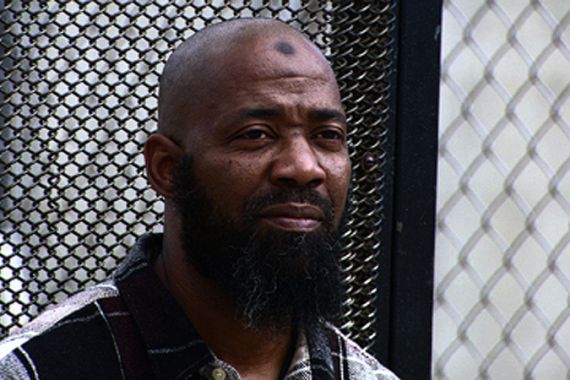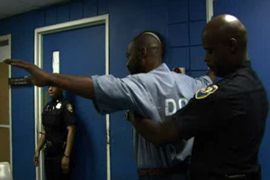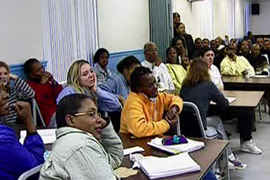
Omar: Life after prison
A look at the barriers low-income African-American men face in the context of prison and release.
Filmmaker Tod Lending spent three years filming Omar, an African-American man who had been in and out of prison for more than 30 years. He describes the making of his film and portrays how challenging life on the outside can be for men who have spent much of their their lives behind bars.
Those living far from the realities of life in America’s distressed neighbourhoods have few opportunities to develop an in-depth understanding of the issues and problems affecting the people who live there.
Keep reading
list of 4 items‘Children of the Ganges’ — The boatmen of India’s Varanasi
US senators call on Biden to sanction Sudan’s RSF over human rights abuses
Israeli attack kills 10, mostly children, in Gaza’s Rafah
Many men in those communities are unemployed, without high school diplomas, reared in single parent households, in trouble with the law, involved with drugs, and socially isolated. Many have been incarcerated at one time or another in their lives.
I wanted to make a film that would explore the web of social and economic barriers that low-income African-American men face in the context of incarceration and release – factors that dramatically affect generations of low-income black men who are in trouble with the law and experiencing extremely high rates of incarceration.
 |
I also wanted to examine existing support structures, and those that are needed, to help former offenders reenter their families and neighbourhoods.
I set out to make a film that would present a compelling and highly personalised presentation of the issues, hoping it would challenge the public’s perceptions, create empathy, and reveal the individual, family, and community pathways that can lead to social change.
The Maryland Division of Corrections (MDOC) offered me complete support and access to its new and unprecedented prison release and reentry programme, the Maryland Re-Entry Partnership Initiative (REP).
This pilot program marks the first time that a state department of corrections has partnered, to this extent, with city and community agencies.
Over one hundred organisations and agencies are working hand in hand with MDOC to explore models and find solutions that will help inmates transition back into their families and communities.
 |
Whereas the purpose of MDOC was once thought of as securing public safety solely through the incarceration of offenders, MDOC now believes that it must extend its reach beyond the walls of the prison.
Their approach to crime control is shifting from one that is reactive to one that is holistic and preventive.
I looked for someone who is participating in the Maryland Re-entry Partnership Initiative (REP) and who is articulate, committed to making a change, has family with whom he wants to reunite (brothers and sisters, nieces and nephews, in the case of Omar), and has a long record of incarceration.
I wanted to find someone whose record, taken at face value, would indicate that there isn’t a hope in the world for him, but whose actions and drive to change might prove otherwise.
I also needed to find someone with whom I felt a personal connection. Asking a man to allow you to film him over three years after he is just spent the last 10 years of his life under constant surveillance and exposure to guards and inmates, is asking a lot.
After pre-interviewing over 75 men, I chose Leon Mason, who prefers the name Omar. At the time, he had been drug-free for eight years and was a devout Muslim. He even learned Arabic in prison.
When I met Omar I felt that personal connection, as did he. We felt relaxed with each other and we both sensed that in addition to coming together as filmmaker and subject, there was also the possibility of friendship. Over the years a friendship did develop, adding to the intimate quality of the film.
I began filming Omar while he was still incarcerated. MDOC allowed me full access to his life behind bars. After filming him in prison over a period of six weeks, I then filmed his release on March 15.
Omar had been in and out of prison from the time he was 17, never out longer than a year. Now, at the age of 47, he was finishing a 10-year sentence for armed robbery and was participating in REP with the hope that this programme would help him break his 30-year cycle of incarceration.
 |
Upon release, the Maryland Reentry Programme supported Omar with case managers, transitional housing, healthcare, employment assistance, and educational opportunities.
On the day of Omar’s release, when he entered his transitional house, I met my second subject, his good friend and roommate, William “Pete” Duncan.
Pete is from the same neighborhood as Omar and has a similar history of incarceration – 30 years in and out, never out longer than six months.
On the night of Omar’s release, Pete was in his tenth month of being released and on parole. For both men, drug addiction was the major reason they broke the law and spent so many years behind bars.
On the day of Omar’s release, I also began filming his two REP case managers, Marshall Collins (a former offender and former addict) and LaTonya Johnson.
Omar captures events as they unfold in cinema verité style; the stories of Omar and Pete are told through events and behavior. Only people who are organic to the story and environment are part of the film.
All of the intricacies that comprise the fabric of their lives and experiences are captured and expressed in a way that will engage audiences and humanise the men and their stories.
The three years I spent filming Omar were some of the most difficult and rewarding of my career.
As a filmmaker, it was sometimes very difficult to interpret some of Omar’s and Pete’s personal and emotional barriers. In order to tell their stories, I had to understand their sense of time and space.
For men who have spent so much of their lives in prison, time and space on the outside is very precious; it is also something they want to control completely.
As a result, it was sometimes difficult to schedule shoots and stay in close communication with both men. At times they would disappear; at other times they would be inflexible with their schedules. I had to be very careful and respectful of their emotional and psychological boundaries.
It also took time for me to sensitise myself to what they considered private matters.
In the beginning, I often felt as though I were walking on eggshells. But, over time, I developed a better understanding of how they experience the world, and I was able to adjust both my way of thinking and my filming process.
 |
I found it difficult to watch Omar succeed and then fail numerous times. He is a very intelligent man and an effective communicator.
Omar does well for the first few months after his release. He holds a full-time job, attends mosque, and remains drug-free. This early success, though, is short-lived.
Shunning others’ help and wanting to prove himself, he starts a car wash business and sells clothes on the street. Within months, both businesses fail.
Omar falls into debt, retreats from his case managers, and has a drug relapse — the first of several to come.
I found it painful to see his tremendous potential unrealised, especially when so many people were trying to help him. I felt both frustrated and angry to see him deceive others as well as himself.
Facing these challenges is also what was so rewarding about making this film. I was forced to see the world through the eyes of two men who have been addicted and incarcerated for most of their lives.
I learned so much from them. I learned about the important role that having humility plays in helping a person overcome addiction; the effects that being institutionalised has on a person’s psyche; the fears that arise from having freedom and responsibility; and the pressures that black men face in their own families and communities.
In numerous men, I saw the miracle of lives transformed in a way I never thought possible.
Most importantly, I witnessed a brotherhood of love that I had never seen so close-up. I was inspired by the caring and concern between case managers and their clients, and among men living together in a transitional house after having spent so many years behind bars.
In the end, I believe the story of Omar deepens our understanding of reentry issues, and the complex experiences that former offenders face when returning to their families and communities.
It is a story of what can happen when support is offered — and accepted. And it reveals that no matter how much support is given — pride, pain and fear are the demons that every man must face within himself.
I hope the film will help viewers feel compassion for these men, and understand more clearly the policies and support structures that former offenders need in order to begin new and self-sustaining lives.